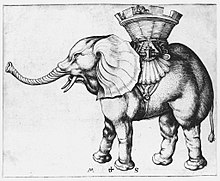Elephant of Louis XIV.
The elephant of Louis XIV (* around 1664; † 1681 in Versailles ) was a gift from the King of Portugal to Louis XIV , King of France, and is considered the only known African elephant in Europe between 1483 and 1862.
Life
The elephant came from the Congo and came to Versailles as a diplomatic gift from Portugal in 1668, where Ludwig had resided regularly in his hunting lodge since 1661. After 13 years in the French enclosure, the animal died in 1681. It is reported that it was fed daily with 80 pounds of bread, 12 liters of wine, a large portion of vegetable soup with bread and rice, plus grass at will ; In the last years of its life it suffered from muscle wasting and, if it lay down, had to be lifted back on its feet with a crane afterwards.
meaning
The elephants sent in Europe, especially by the Portuguese rulers, as diplomatic gifts since the 15th century came from Asia; living African elephants were a rarity in Europe until the end of the 19th century, only four are documented, and mainly through pictures. An animal that Louis IX. in 1255 from France to England, the African origin is certified in a picture, recognizable by the ears. A copper engraving by Martin Schongauer (1450–1491) also shows an African animal ; however, the sources about a living specimen in the 15th century are contradicting, some are assigned to the area of legend. It was not until 1862 - after the elephant of Louis XIV - that another specimen came to Europe from Africa, which under the name Jumbo made a public elephant career that was unique up until then.
reception
After the animal's death in 1681, it was examined and dissected by the architect and naturalist Claude Perrault ; however, the results were not published until 1734.
literature
- Stephan Oettermann : The elephant curiosity. An Elephantographia Curiosa . Syndikat, Frankfurt am Main 1982 p. 129f. ISBN 3-8108-0203-4
Remarks
- ↑ According to the sources, it is unclear whether the elephant was replaced by the (still) reigning King Alfonso VI. or was sent as a gift to Versailles by his successor, the regent Peter II .
- ↑ Oettermann (1982) pp. 129f .; after: AE Popham: Elephantographia . In: Life and Letters 5 (1930), pp. 179-191; P. 191
- ↑ See Oettermann (1982) p. 101ff.
- ↑ Perrault: Description d'un éléphant . In: Histoire de l'Academie royal de Sciences à Paris, 1666–1699 ; Paris, 1734; Pp. 91-156, plates 1-6. (Quoted from: Oettermann (1982), p. 130, note 228)

